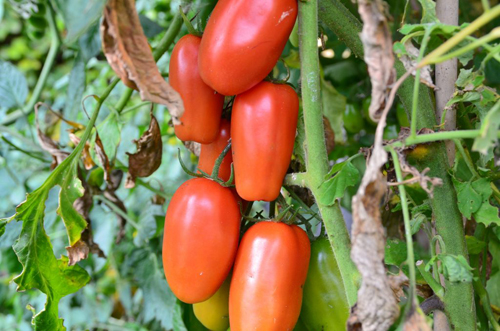Tomato variety Moscow delicacy
Attractive fruit shape, excellent taste, good yield - all these positive characteristics describe the Moscow delicacy tomato. The variety was brought to ZAO Scientific and Production Corporation LTD, in 1998 an application for its registration was filed. The tomato was entered into the State Register of Breeding Achievements of the Russian Federation in 2001, and received admission in all regions of Russia. Recommended for garden plots, backyards and small farms, it works well in the open field, but in cooler regions the variety is often grown in protected. Not a hybrid.

Description
Refers to indeterminants. Even in open ground, the height reaches one and a half meters, the maximum height is indicated about 1.8 meters, but in a greenhouse it can grow up to 2. The stem does not differ in power, internodes are long, foliage is good. Leaves are usually green in color. The leaf plate is large, slightly corrugated. Yellow flowers are collected in a simple type of inflorescence, sometimes intermediate. The first fruit cluster is formed, like all tall tomatoes, over 9-11 leaves. Subsequent ones are formed in 3 - 4 sheets. Each cluster has about 6 ovaries. The peduncle of the variety has an articulation.
The fruits of the Moscow delicacy are of an interesting shape, pepper-shaped or cylindrical. Very dense, the ribbing is poorly expressed. An unripe tomato is colored green with a darker contrasting spot near the stalk. The skin is quite firm and glossy. As it ripens, the fruit turns into an even red color, the stain disappears. The pulp is dense, fleshy, low-liquid (some note excessive dryness of the pulp) and low-seeded - contains only 2 seed nests. Sometimes gardeners complain about voids in the fruit. The pulp is characterized by a high sugar content, so the taste is excellent. The mass of tomatoes is from 80 to 130 grams.

Variety characteristics
- The ripening period of the Moscow delicacy is average. After germination, it takes about 120 days to harvest;
- the yield of marketable fruits is good - 5.7 - 6 kg per 1 square meter;
- the plant is resistant to diseases and pests. According to gardeners, it perfectly resists phytophthora, both in open ground and in protected;
- ripe tomatoes do not burst;
- in unprotected soil, the tomato can withstand possible temperature changes well, bears fruit before the onset of cold weather;
- due to the dense structure and strong skin, long-term transportation does not affect the commercial qualities of the fruits of the Moscow delicacy;
- keeping quality for such a perishable product is good;
- The State Register indicates the salad purpose of using the fruits, but many housewives prefer to start the harvest for processing - excellent pasta, mashed potatoes, sauce are obtained from the low-liquid pulp. Tomatoes of this variety are excellent for pickling and preserving, the skin does not burst during heat treatment. Even when canning in pieces, the tomatoes keep their shape.

Agrotechnics
Sowing for seedlings is carried out 60 - 65 days before disembarking to a permanent place. The sowing time of seeds in each region is best calculated based on the weather conditions. A pick in the phase of 2 true leaves is mandatory. Before planting seedlings in the garden, hardening is necessary. The planting scheme of the Moscow delicacy is usual - 40 cm between bushes and 50 cm row spacing. Allowable density - 3 - 4 plants per 1 square meter. The bush is formed into 1 or 2 stems. The latter option increases the yield of the variety. A garter on a trellis or support is required. The care is standard for the culture as a whole.The only caveat is that the planting site must be sunny, otherwise the taste of the fruit will be inexpressive. This problem is often reported by those who grow the variety in a greenhouse.
The Moscow delicacy is perfect for those gardeners who value stability and productivity. A pleasant addition to this is the wonderful taste of sun-ripened tomatoes and their versatile use. A good immunity of the variety will reduce the number of treatments to a minimum, which will help to grow an environmentally friendly crop. The disadvantages are the same as in all tall crops - a garter and bush formation are required.








